Steam heating in a private house and in a country house based on a stove or boiler
Efficient home heating is one of the most important tasks for every homeowner. An interesting solution to this problem can be a steam heating system, the principles of operation and device of which differ from the usual water circuits.
This is not the easiest option, with its own strengths and weaknesses. We will talk about the rules of the device and organization, the features of the system with a vaporous coolant. You will learn how to arrange steam heating in a private house and how to properly operate it.
The content of the article:
The principle of the steam system
When water boils at a constant pressure, it keeps its temperature constant. The steam generated as a result of such boiling has a significant amount of thermal energy. At the time of condensation, i.e. when steam is converted into liquid, this energy is released and transferred to the environment.
This principle is used in the operation of steam heating systems. Water boils in the boiler, steam moves through pipes to radiators, it condenses and partes with the heat, thereby heating the air in the room.
The water obtained in the process of condensation continues to move through the pipes and returns to a special storage tank, and then it enters the heater naturally or forcefully using a pump.
Depending on the pressure inside the steam heating system, they are divided into:
- vacuum steam;
- low pressure;
- high pressure.
In the first, the pressure is less than 0.1 MPa, in the second - even lower - to 0.07 MPa, and in the third - more than 0.07 MPa. Open low pressure systems have access to air from the atmosphere, but they can also be closed, i.e. completely airtight.
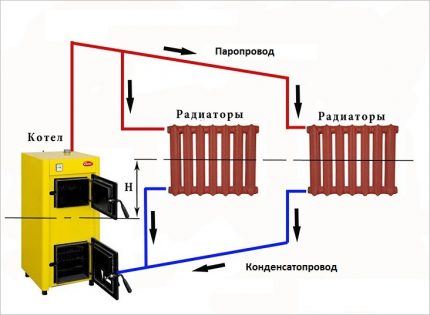
Such systems typically use so-called dry saturated steam, which does not contain suspended particles of water. The amount of steam in the system is reflected in its work. If the steam is too small, this will create problems for the condensate to drain freely, and cold air will collect at the bottom of the heater.
A sufficient volume of steam improves the process of outflow of condensate, which is pushed to the walls and flows down them in the form of a thin water film.
In closed systems, water after condensation immediately enters the heat exchanger, but often open systems are used in which the coolant is first collected in the storage tank and then pumped to the boiler for heating.
Condensate can completely fill the pipes through which it moves for heating or only partially. The latter option is preferable, since when the system is turned off, the pipes in it will remain dry.
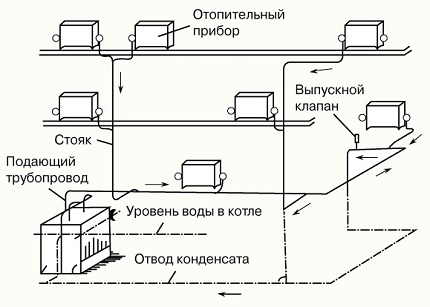
Features of low pressure systems
A common version of such a system is closed, using gravity returning condensate to the boiler, which does not completely fill the pipes, and the upper pipe layout is used.
First, the system is filled with water to the required level, after which heating begins. Condensate flows down the common riser and when it reaches the set level it is forced out into the boiler.
In the same system with a lower wiring, it is recommended to install pipes with a slight slope in the direction of vapor movement in order to reduce sound effects. A loop-shaped water trap is arranged at the condensate drainage site, which prevents the steam from moving to the condensation line.
The vapor velocity in such systems should be moderate, not more than 0.14 m / s. Otherwise, steam will also capture particles of moisture accumulated on the walls. As a result, the system works with a lot of noise, increasing the risk of water hammer.
Combined wiring, i.e.a combination of upper and lower wiring, used if pipes are laid under the floor of the upper or middle floor of the house. Clearance of pipes through which water is returned to the boiler, in this case will be closed by condensate.
If the pressure in the system exceeds 0.02 MPa, it should be made open. Air is removed through the condensate storage tank, and to prevent the steam from leaving the system, a steam trap or a water trap are installed. Water is pumped from the accumulator to the heat exchanger by a pump, which allows the accumulator to be installed below the level at which the heat exchanger is located.
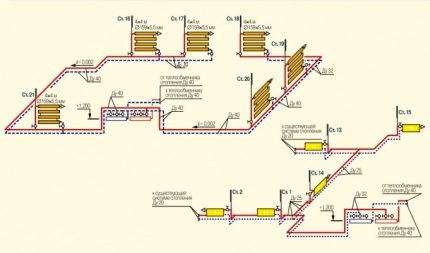
Assessment of advantages and disadvantages
What is a good steam heating system? It is relatively easy to make even on the basis of a conventional wood-burning stove. This is especially true in areas where there is no centralized gas supply, and firewood or other solid fuels are readily available.
Steam as a heat carrier is significantly ahead of water. The rate of warming up the premises is three times higher. In addition, the steam heating system can hardly fail during the winter cold due to the lack of heating.
If the furnace burns out, water from the system will be collected in the storage tank or in the heat exchanger, and the pipes and radiators will remain empty. With water heating, the freezing of the coolant with which the entire circuit is filled, as is known, leads to pipe rupture.
Finally, the dimensions of steam heating radiators should be significantly smaller than for water systems, since the amount of thermal energy resulting from this increases several times. This will slightly reduce the cost of installing a heating system at home.
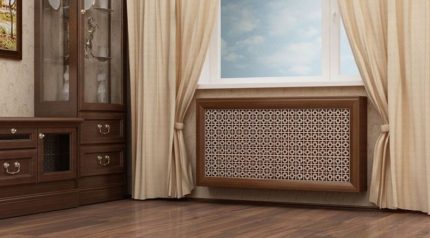
This concludes the list of advantages of the steam system, and we can proceed to its disadvantages, which are quite significant:
- high risk of burns;
- increased noise level during operation;
- difficulties with adjusting the system;
- the need to purchase expensive pipes, etc.
Safety standards do not recommend steam heating for residential premises, since it is a high risk to the health and life of people living in the house.
So, the operating temperature of the radiators will be very high, if you touch them, you can get a serious burn. Therefore, all radiators will have to be closed with reliable decorative grilles.
Conventional PVC pipes for such a system will not work, because they must withstand high pressure and a temperature of more than 100 degrees. The same requirements apply to other elements of the system. Steam heating pipes should be copper or made of galvanized steel.
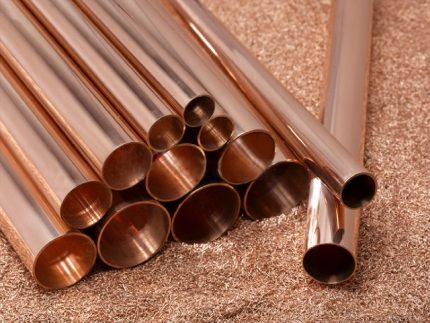
In any case, this moment cannot be called budget. Security issues should receive the closest attention. All installation work, for example, welding of copper pipes, will require the highest quality performance. If the connection breaks out and a stream of steam escapes into the hole, one of the tenants at home risks serious burns.
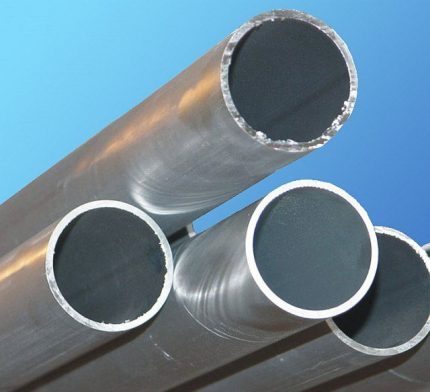
Another disadvantage of steam heating is the increased noise level. To fix this problem, the radiators must be installed correctly. They are suspended on special anti-noise brackets. A boiler or oven is best placed in a separate room.In addition, copper pipes can be placed in the thickness of the walls, which will also reduce the noise level.
Finally, it is a little difficult to control the heating temperature in rooms with steam heating. You can not install a thermostat and simply reduce the amount of steam. It is necessary to reduce the amount of fuel, which is not always easy, or to ventilate the premises. Before starting work on installing a steam heating system, all these points should be taken into account.
Designing a steam heating system
Even for a small room, it’s best to design a project. A system made “at random” with a high degree of probability will soon require rework, and a paper-based diagram will immediately identify weaknesses and correct them.
For example, in order to create a system with natural circulation of the coolant, the heat exchanger, and, accordingly, the heating device, should be located at the lowest point of the house.
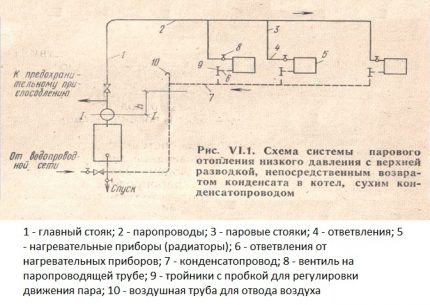
This means that the stove or boiler must be below all radiators, as well as pipes that are not standing vertically, but horizontally or at an angle to the vertical.
If the heater cannot be placed in this way (there is no basement in the house, the basement is used for other purposes, etc.), heating with forced circulation should be preferred.
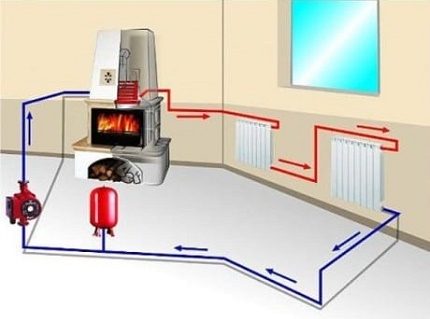
Therefore in steam heating circuit you must turn on the pump, which will pump water into the heat exchanger. An important point in the design of the heating system is the procedure for connecting radiators. Serial connection or the so-called one-pipe system involves the connection of all radiators in order.
As a result, the coolant will move sequentially through the system, gradually cooling. This is an economical connection option, which is easier to install and cheaper at a cost.
But the uniformity of heating with this method will suffer, since the first radiator will be the hottest, and the last heat carrier will arrive in an already half-cooled state.
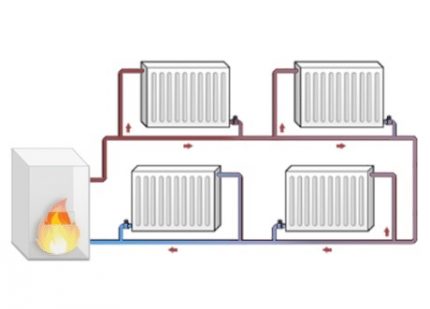
A one-pipe solution may be acceptable only when connecting steam heating in the country or in a small house, on an area of less than 80 square meters. m. And for a spacious cottage or a two-story building, a two-pipe system is more suitable, in which radiators are connected in parallel.
A single-pipe scheme provides simultaneous, but not sequential, flow of coolant to each radiator, and the rooms are heated more evenly. But with a two-pipe circuit, two pipes will have to be connected to each radiator: direct and “return”.
Such a system is more difficult to implement, and it will cost a little more than when installing a single-tube system. However, the vast majority of water heating systems are made according to the two-pipe scheme, despite the difficulties, and function quite successfully.

If you are planning to use a wood-burning stove as a heat source, you should immediately calculate and design a special heat exchanger. It looks like a coil welded from metal pipes. This element is built directly into the design of the furnace, and not installed separately.
Therefore, the design of a new furnace should also be considered at the design stage.You can use an existing oven, but it will have to be partially disassembled to mount the heat exchanger inside.
To obtain 9 kW of heat, a heat exchanger with a surface area of about one square meter is required. The larger the heated area, the larger the dimensions of the heat exchanger should be.
If it is supposed to heat the room with the help of a boiler, then everything is a little easier: you need to buy and install it. Usually for steam heating in the house it is recommended to take a water-tube model of the boiler, as the most effective.
Although fire-tube, smoke-filled or combined smoke-fire-tube models can also be a perfectly acceptable option.
Sometimes for the organization of steam heating use homemade boilerin which used oil is burned. But this option is considered suitable for use in utility rooms, for example, in a garage. For a residential building, this option is not too good.
Mounting on the basis of a wood stove
If the project is drawn up, it's time to stock up on the right materials and tools. Calculate the required number of system elements will allow a previously compiled project.
All turns, connections, tees, radiator installation locations, etc. should be marked on it. In addition, it is necessary to purchase pipe clamps, as well as brackets on which radiators will be installed.
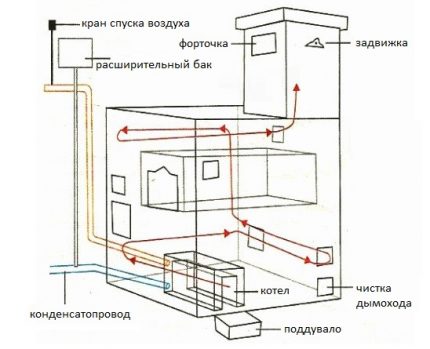
The length of the pipes is also calculated according to the scheme. In order to reduce the steam pressure in the system if necessary, a pressure reducing valve is needed. A hydraulic shutter is needed to allow the system to be completely drained for cleaning, maintenance or repair.
Before each radiator, it is recommended to install a shut-off valve, which will turn it off for repair, flushing or replacement. Also installed on radiators Mayevsky cranesto blow air into the system. Although steam is a gaseous and not a liquid substance, the presence of air in the system can adversely affect its effectiveness.
In order for the condensation process to occur precisely in the radiators, and not in the drive or in the riser, it is recommended to install a tee with a plug through which only water will pass. If you plan to install a system with forced circulation, you will need a circulation pump. In addition, you need a container to collect condensed moisture.
Gravity systems do not need such devices. But the pipe, through which water is directed to the heat exchanger, should be wide enough to provide quick movement of the liquid for further heating.
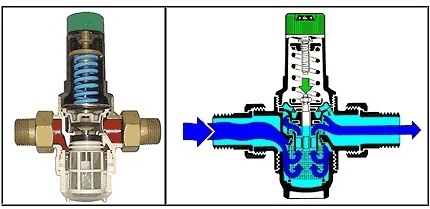
In addition to the usual installation tool, you will definitely need a welding machine for copper pipe joints. Galvanized steel structures usually have threaded connections that must be carefully sealed. If you plan to install steam heating from the furnace, you will have to start with the manufacture of a heat exchanger.
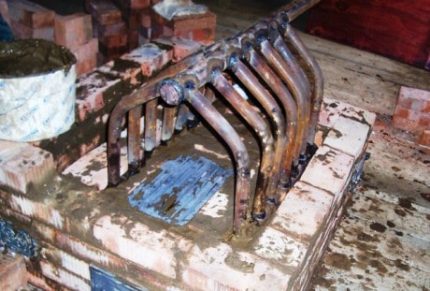
It is cooked from metal pipes 2.5-3 mm thick or even slightly thicker. The heat exchanger can be made both in the form of a coil, and in any other form. The main thing is that the device fits inside wood stove, and also so that its surface is large enough to heat water and generate steam.
The welding quality of the heat exchanger should be, without exaggeration, ideal.Even microscopic caverns in the seams are unacceptable, since the device will be exposed to high pressure from hot steam. After the heat exchanger is ready for installation, each weld should be checked.
To do this, first all the seams are smeared with white chalk. After that, one of the openings of the heat exchanger is closed, and kerosene is poured into the second until the device is filled to the top. Now you need to wait a bit, and then evaluate the condition of the seams. If there are cracks, kerosene will leak through them, and in such places the chalk will darken.
Identified flaws are corrected, and then the test is repeated to verify the integrity of the device. Now it should be washed, and then start laying the wood-burning stove. The heat exchanger is built into the firebox reliably, and pipes are added to its input and output, which are then used to connect the heat exchanger to the heating system of the house.
The laying of the furnace is completed in the usual manner for such structures. Then the pipes and radiators of the heating system are installed in accordance with the design drawn up earlier. First, radiators are installed using brackets that absorb the noise from the operation of steam heating.
Mayevsky taps are installed on each radiator so that air can be released. You will need one more stopcock than radiators, since you need to install one common stopcock at the very beginning of the system. A pressure reducing valve and a reduction and cooling unit are also placed in front of this tap.
In the end, if it is provided for by the project, install a drive for the coolant and circulation pump. For systems designed with natural rather than forced circulation, a tank and pump are not needed. But the pipe that leads to the heat exchanger needs to be given a slight slope of about 3 mm per meter.
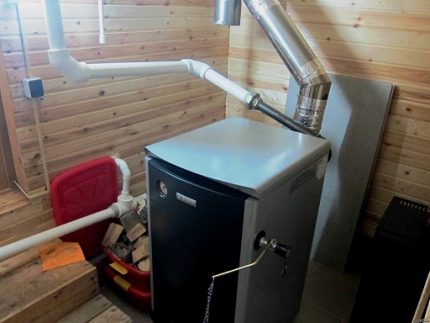
Systems with a steam boiler are mounted in approximately the same way: in accordance with the design and adjusted for equipment features. For example, a pressure reducing valve and a cooler are most likely not needed, since a steam pressure and temperature control system is already integrated in the boiler.
Some useful tips
When installing a steam heating system, it should be remembered that all its elements must withstand high temperatures, more than 100 degrees. For example, a conventional membrane expander as a reserve capacity in case of an increase in the volume of coolant will not work, because its maximum is 85 degrees.
The chimney of the furnace, in which the heat exchanger is built in, will be more contaminated faster than a conventional stove. therefore chimney sweep need to plan and execute more often.
An oven with a heat exchanger can also be used for cooking, if desired, but this is not very convenient. In the summer, when heating is not necessary, this stove cannot be ignited. Will have to look for an alternative. It’s easier if there is a separate convenient stove for the kitchen in the house.
How to design and assemble a steam heating system with your own hands is described in detail. in this articlerecommended by us for reading.
Conclusions and useful video on the topic
Practical experience on converting a wood stove into a steam heating boiler is presented in this video:
The continuation of the installation of steam heating can be found in this file:
The difference between forced and natural circulation in heating systems is described in detail here:
Steam heating is not the easiest option to implement an autonomous heating system. But with proper design and installation with steam, you can efficiently and relatively inexpensively provide your home with the necessary amount of heat.
Please comment on the information that we submitted for consideration.Ask questions, share useful information and leave a photo on the topic of the article. Below is a block form designed for posting and communication.

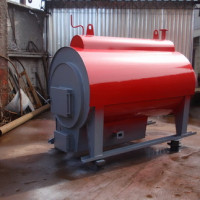 How to make steam heating yourself: device, rules and requirements
How to make steam heating yourself: device, rules and requirements 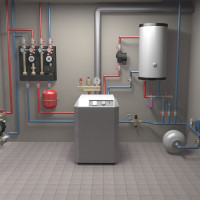 Water heating in a private house: rules, norms and organization options
Water heating in a private house: rules, norms and organization options 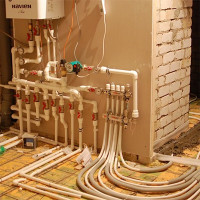 Optimal wiring of heating in a private house: a comparison of all typical schemes
Optimal wiring of heating in a private house: a comparison of all typical schemes 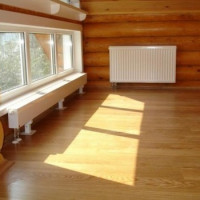 Heating in a wooden house: a comparative overview of suitable systems for a wooden house
Heating in a wooden house: a comparative overview of suitable systems for a wooden house 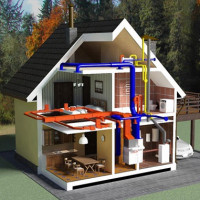 Heating scheme from a gas boiler in a two-story house: a review and comparison of the best heating schemes
Heating scheme from a gas boiler in a two-story house: a review and comparison of the best heating schemes 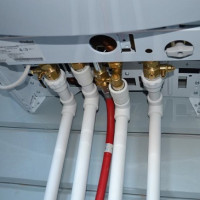 How the boiler is strapped with polypropylene: the rules for the construction of the pp circuit
How the boiler is strapped with polypropylene: the rules for the construction of the pp circuit  How much does it cost to connect gas to a private house: the price of organizing gas supply
How much does it cost to connect gas to a private house: the price of organizing gas supply  The best washing machines with dryer: model rating and customer tips
The best washing machines with dryer: model rating and customer tips  What is the color temperature of light and the nuances of choosing the temperature of the lamps to suit your needs
What is the color temperature of light and the nuances of choosing the temperature of the lamps to suit your needs  Replacement of a geyser in an apartment: replacement paperwork + basic norms and requirements
Replacement of a geyser in an apartment: replacement paperwork + basic norms and requirements
It is clear that such heating is very effective, but really it is necessary to evaluate not so much its advantages as disadvantages. Personally, I see the main drawback not only the cost of installing steam heating, but also that there will be problems with the temperature control. By the way, care for such systems is very clear. I would recommend staying on ordinary - water heating.
I have not seen steam heating in Finland. Friends have their own house there, in winter they do not use it. They fill in the “non-freezing” in the traditional heating system, but if you expect frosts below -15 degrees, it is completely drained from the system anyway. Steam in this case would be less troublesome, but the costs of re-equipping the system are huge, no one goes for it. It is better to lay such a heating system initially during construction at the request of customers.